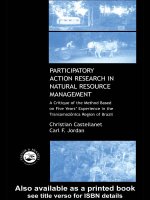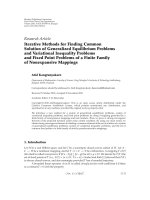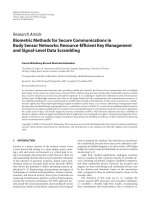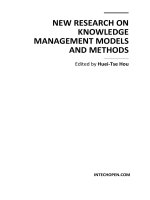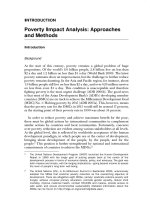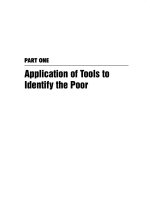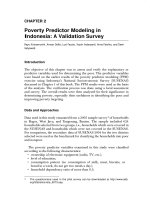Participatory action research approaches and methods
Bạn đang xem bản rút gọn của tài liệu. Xem và tải ngay bản đầy đủ của tài liệu tại đây (2.84 MB, 287 trang )
Participatory Action Research
Approaches and Methods
Participatory Action Research (PAR) approaches and methods have seen an explosion of recent interest in the social and environmental sciences. PAR involves
collaborative research, education and action oriented towards social change, representing a major epistemological challenge to mainstream research traditions. It has
recently been the subject of heated critique and debate, and rapid theoretical and
methodological development.
This book captures these developments, exploring the justification, theorisation,
practice and implications of PAR. It offers a critical introduction to understanding
and working with PAR in different social, spatial and institutional contexts. The
authors engage with PAR’s radical potential, while maintaining a critical awareness
of its challenges and dangers. Part I explores the intellectual, ethical and pragmatic
contexts of PAR; the development and diversity of approaches to PAR; recent
poststructuralist perspectives on PAR as a form of power; the ethics of participation;
and issues of safety and well-being. Part II is a critical exploration of the politics,
places and practices of PAR, exploring methods including diagramming, cartographies, art, theatre, photovoice, video and geographical information systems are
also discussed. Part III reflects on how effective PAR is, including the analysis of its
products and processes, participatory learning, representation and dissemination,
institutional benefits and challenges, and working between research, action,
activism and change.
The authors find that a spatial perspective and an attention to scale offer helpful
means of negotiating the potentials and paradoxes of PAR. The book adds significant weight to the recent critical reappraisal of PAR, suggesting why, when, where
and how we might take forward PAR’s commitment to enabling collaborative
social transformation. It will be particularly useful to researchers and students of
Human Geography, Development Studies and Sociology.
Sara Kindon is a Senior Lecturer in Human Geography and Development Studies
at Victoria University of Wellington, Aotearoa New Zealand.
Rachel Pain is a social geographer at Durham University in the UK.
Mike Kesby is a Lecturer in Human Geography at the University of St Andrews,
Scotland, UK.
Routledge Studies in Human Geography
This series provides a forum for innovative, vibrant, and critical debate within
Human Geography. Titles will reflect the wealth of research which is taking place
in this diverse and ever-expanding field. Contributions will be drawn from the
main sub-disciplines and from innovative areas of work which have no particular
sub-disciplinary allegiances.
Published:
1. A Geography of Islands
Small island insularity
Stephen A. Royle
2. Citizenships, Contingency and
the Countryside
Rights, culture, land and the
environment
Gavin Parker
3. The Differentiated Countryside
Jonathan Murdoch, Philip Lowe,
Neil Ward and Terry Marsden
7. Rural Poverty
Marginalisation and exclusion in
Britain and the United States
Paul Milbourne
8. Poverty and the Third Way
Colin C. Williams and
Jan Windebank
9. Ageing and Place
Edited by Gavin J. Andrews and
David R. Phillips
4. The Human Geography of East
Central Europe
David Turnock
10. Geographies of Commodity
Chains
Edited by Alex Hughes and
Suzanne Reimer
5. Imagined Regional Communities
Integration and sovereignty in the
Global South
James D Sidaway
11. Queering Tourism
Paradoxical performances at gay
pride parades
Lynda T. Johnston
6. Mapping Modernities
Geographies of Central and
Eastern Europe 1920–2000
Alan Dingsdale
12. Cross-Continental Food Chains
Edited by Niels Fold and
Bill Pritchard
13. Private Cities
Edited by Georg Glasze, Chris
Webster and Klaus Frantz
14. Global Geographies of Post
Socialist Transition
Tassilo Herrschel
15. Urban Development in PostReform China
Fulong Wu, Jiang Xu and
Anthony Gar-On Yeh
21. China on the Move
Migration, the state, and the
household
C. Cindy Fan
22. Participatory Action Research
Approaches and Methods
Connecting people, participation
and place
Sara Kindon, Rachel Pain and
Mike Kesby
Not yet published:
16. Rural Governance
International perspectives
Edited by Lynda Cheshire,
Vaughan Higgins and
Geoffrey Lawrence
17. Global Perspectives on Rural
Childhood and Youth
Young rural lives
Edited by Ruth Panelli, Samantha
Punch, and Elsbeth Robson
18. World City Syndrome
Neoliberalism and inequality in
Cape Town
David A. McDonald
23. Time Space Compression
Historical geographies
Barney Warf
24. International Migration and
Knowledge
Allan Williams and Vladimir Balaz
25. Design Economies and the
Changing World Economy
Innovation, production and
competitiveness
John Bryson and Grete Rustin
19. Exploring Post Development
Aram Ziai
26. Whose Urban Renaissance?
An international comparison of
urban regeneration policies
Libby Porter and Katie Shaw
20. Family Farms
Harold Brookfield and
Helen Parsons
27. Tourism Geography
A new synthesis, second edition
Stephen Williams
Frontispiece
I am here. Self Portrait is about who you are. Who you are is what you
believe you are. It’s me, Gaby Kitoko. I’m here ready to act. Never doubt –
we can make a difference together (Credit: Gaby Kitoko for Media 19/ Self
Portrait Refugee).
Participatory Action Research
Approaches and Methods
Connecting people, participation and place
Edited by
Sara Kindon, Rachel Pain
and Mike Kesby
First published 2007 by Routledge
2 Park Square, Milton Park, Abingdon, Oxon OX14 4RN
Simultaneously published in the USA and Canada
by Routledge
270 Madison Avenue, New York, NY 10016
This edition published in the Taylor & Francis e-Library, 2007.
“To purchase your own copy of this or any of Taylor & Francis or Routledge’s
collection of thousands of eBooks please go to www.eBookstore.tandf.co.uk.”
Routledge is an imprint of the Taylor & Francis Group, an informa business
© 2007 Editorial selection and matter, Sara Kindon, Rachel Pain and Mike
Kesby; individual chapters, the contributors
All rights reserved. No part of this book may be reprinted or reproduced or
utilised in any form or by any electronic, mechanical, or other means, now
known or hereafter invented, including photocopying and recording, or in
any information storage or retrieval system, without permission in writing
from the publishers.
British Library Cataloguing in Publication Data
A catalogue record for this book is available from the British Library
Library of Congress Cataloging in Publication Data
Participatory action research approaches and methods : connecting people,
participation, and place / [edited] by Sara Kindon, Rachel Pain and Mike
Kesby.
p. cm.
Includes bibliographical references and index.
1. Social participation—Research—Methodology. 2. Political
participation—Research—Methodology. 3. Communities—Research—
Methodology. I. Kindon, Sara Louise. II. Pain, Rachel. III. Kesby,
Mike, 1966–
HM711.P37 2007
302'.1401—dc22
2007024739
ISBN 0-203-93367-2 Master e-book ISBN
ISBN10: 0-415-40550-5 (hbk)
ISBN10: 0-203-93367-2 (ebk)
ISBN13: 978-0-415-40550-8 (hbk)
ISBN13: 978-0-203-93367-1 (ebk)
We dedicate this book to Janet Townsend to honour her work in
pioneering feminist and participatory approaches in Geography,
and to acknowledge the profound impacts of her critical intellect
and gentle manner on our own thinking and practice.
Contents
List of boxes
List of figures
List of plates
Notes on contributors
Foreword
Acknowledgements
1
Introduction: connecting people, participation and place
xiii
xv
xvi
xvii
xxiii
xxv
1
SARA KINDON, RACHEL PAIN AND MIKE KESBY
PART I
Reflection
7
2
9
Participatory Action Research: origins, approaches and methods
SARA KINDON, RACHEL PAIN AND MIKE KESBY
3
Participation as a form of power: retheorising empowerment and
spatialising Participatory Action Research
19
MIKE KESBY, SARA KINDON AND RACHEL PAIN
4
Participatory Action Research: making a difference to theory,
practice and action
26
RACHEL PAIN, SARA KINDON AND MIKE KESBY
5
Toward a participatory ethics
33
LYNNE C. MANZO AND NATHAN BRIGHTBILL
6
Participatory Action Research and researcher safety
MAGS ADAMS AND GEMMA MOORE
41
x Contents
PART II
Action
7 Environment and development: (re)connecting community and
commons in New England fisheries, USA
49
51
KEVIN ST. MARTIN AND MADELEINE HALL-ARBER
8 Working towards and beyond collaborative resource management:
parks, people, and participation in the Peruvian Amazon
60
MICHAEL C. GAVIN, ALAKA WALI AND MIGUEL VASQUEZ
9 Researching sexual health: two Participatory Action Research
projects in Zimbabwe
71
MIKE KESBY AND FUNGISAI GWANZURA-OTTEMOLLER
10 Gender and employment: participatory social auditing in Kenya
80
MAGGIE OPONDO, CATHERINE DOLAN, SENORINA WENDOH AND
JAMES NDWIGA KATHURI
11 Inclusive methodologies: including disabled people in
Participatory Action Research in Scotland and Canada
88
HAZEL MCFARLANE AND NANCY E. HANSEN
12 Working with migrant communities: collaborating with the
Kalayaan Centre in Vancouver, Canada
95
GERALDINE PRATT, IN COLLABORATION WITH THE PHILIPPINE WOMEN
CENTRE OF B.C. AND UGNAYAN NG KABATAANG PILIPINO SA CANADA/FILIPINOCANADIAN YOUTH ALLIANCE
13 Peer research with youth: negotiating (sub)cultural capital,
place and participation in Aotearoa/New Zealand
104
JANE HIGGINS, KAREN NAIRN AND JUDITH SLIGO
14 Participatory diagramming: a critical view from North
East England
112
CATHERINE ALEXANDER, NATALIE BEALE, MIKE KESBY, SARA KINDON,
JULIA MCMILLAN, RACHEL PAIN AND FRIEDERIKE ZIEGLER
15 Participatory cartographies: reflections from research
performances in Fiji and Tanzania
ELEANOR SANDERSON, WITH HOLY FAMILY SETTLEMENT RESEARCH
TEAM, RUTH NEWPORT, AND UMAKI RESEARCH PARTICIPANTS
122
Contents xi
16 Participatory art: capturing spatial vocabularies in a collaborative
visual methodology with Melanie Carvalho and South Asian
women in London, UK
132
DIVYA P. TOLIA-KELLY
17 Participatory theatre: ‘creating a source for staging an example’
in the USA
141
MARIE CIERI AND ROBBIE MCCAULEY
18 Photovoice: insights into marginalisation through a ‘community
lens’ in Saskatchewan, Canada
150
BRIGETTE KRIEG AND LANA ROBERTS
19 Uniting people with place using participatory video
in Aotearoa/New Zealand: a Ngªti Hauiti journey
160
GEOFFREY HUME-COOK, THOMAS CURTIS, KIRSTY WOODS, JOYCE
POTAKA, ADRIAN TANGAROA WAGNER AND SARA KINDON
20 Participatory GIS: the Humboldt/West Humboldt Park
Community GIS Project, Chicago, USA
170
SARAH ELWOOD, RUBEN FELICIANO, KATHLEEN GEMS, NANDHINI
GULASINGAM, WILLIAM HOWARD, REID MACKIN, ELIUD MEDINA,
NIURIS RAMOS AND SOBEIDA SIERRA
PART III
Reflection
179
21 Participatory data analysis
181
CAITLIN CAHILL, BASED ON WORK WITH THE FED UP HONEYS
22 Participatory learning: opportunities and challenges
188
MARIA STUTTAFORD AND CHRIS COE
23 Beyond the journal article: representations, audience, and the
presentation of Participatory Action Research
196
CAITLIN CAHILL AND MARÍA ELENA TORRE
24 Linking Participatory Research to action: institutional challenges
JENNY CAMERON
206
xii Contents
25 Relating action to activism: theoretical and methodological
reflections
216
PAUL CHATTERTON, DUNCAN FULLER AND PAUL ROUTLEDGE
PART IV
Conclusion
223
26 Conclusion: the space(s) and scale(s) of Participatory
Action Research: constructing empowering geographies?
225
RACHEL PAIN, MIKE KESBY AND SARA KINDON
Bibliography
Index
231
250
Boxes
2.1
2.2
3.1
4.1
4.2
4.3
4.4
6.1
6.2
6.3
6.4
6.5
7.1
8.1
8.2
8.3
9.1
10.1
12.1
12.2
12.3
12.4
13.1
14.1
14.2
14.3
14.4
15.1
15.2
15.3
15.4
15.5
Some current schools of PAR
Key characteristics of PAR and PAR researchers
Some negative power effects of participatory approaches
The place of PAR within human geography
Making a difference to theory through PAR
Making a difference to practice through PAR
Making a difference to action through PAR
Potential dangers in the field
Gemma’s story
Mags’ story
Taking responsibility for safety
Key procedures for personal/personnel safety
Outlines of community territories
In the beginning
The importance of community facilitators
Community participation
Interviewing the diagram in participatory sexual health research
Role play: use of abusive language and inhumane treatment
(Garment Sector)
Faux PAR
Prolonged engagement
Academic legitimisation
Understanding democracy
Research questions on three projects
Diagramming as means to participatory research design
Different responses to diagramming
Participatory mapping with older people
Contextual effects on participatory diagramming encounters
Connections
The poster
The limits of words
Expressing development space
The ‘Blah’ of embodied methodology
12
14
21
27
30
31
32
42
43
44
46
47
58
63
65
68
74
83
96
99
102
102
105
113
115
117
119
126
127
127
128
130
xiv Boxes
15.6
16.1
16.2
16.3
17.1
17.2
17.3
18.1
18.2
18.3
18.4
18.5
19.1
19.2
19.3
19.4
21.1
21.2
22.1
22.2
23.1
23.2
23.3
23.4
23.5
23.6
Changing ourselves
Participatory art
Extract from interview with Melanie Carvalho
Exchange between Lalita and Melanie Carvalho
Typical participatory theatre processes
Principles that guide us
Sample from the script of TURF: A Conversational Concert in
Black and White
Telling our stories
Bringing out the strengths in our community
Seeing what life is really like for us
Encouragement to act
Challenges
Typical stages in a participatory video process
Considering audiences
More choices
Lessons learned working with participatory video
Data analysis as ‘torture’
Valuing confrontation in participatory data analysis
Key characteristics of Kolb’s Experiential Learning
Key points of Knowle’s Andragogical Theory of Adult Learning
Questions about representation, audience and action
Making our voices the centrepiece
The importance of communicating to our peers
Dealing with stereotypes
Negotiating self-representation and ‘truth’
Considering consequences
131
133
136
139
142
143
145
150
153
155
157
158
162
167
167
168
180
184
188
188
194
196
197
199
200
200
Figures
2.1
2.2
2.3
8.1
8.2
8.3
8.4
9.1
15.1
20.1
20.2
24.1
24.2
Key stages in a typical PAR process
Participation continuums
Common methods used in PAR
Resource management strategies and the role of local communities
Map of the Cordillera Azul National Park, Peru
Example of data sheets used in participatory ethnobiological survey
Participatory adaptive management plan for the Cordillera Azul
National Park, Peru
Common contexts for sex (produced by young men who participated
in an NGO HIV education programme)
A conceptual outline of participatory cartographies
Parks, schools, transit lines and community centres in Humboldt Park
Humboldt Park redevelopment area map
Three types of PAR: characteristics and challenges for
academic researchers
Institutional challenges of PAR and strategies for negotiating
the challenges
15
16
17
61
62
64
74
74
124
173
174
207
214
Plates
Frontispiece Never doubt – we can make a difference together
7.1 Outlines of community territories
8.1 Example of a community shield produced as part of the MUF
9.1 Body map (grade six boys)
9.2 Gendered performance: the youth on the left ‘acts like a girl’
10.1 Ranking the problems by tea male workers (pesa
kidogo = insufficient wages)
12.1 Collecting stories at the Philippine Women Centre, August 1995
12.2 Presenting our research at the Kalayaan Centre, Spring 2006
14.1 Favoured methods of all children
14.2 Different responses to diagramming
14.3 A sketch map with photographs taken by participants
14.4 A multi-stage diagram on meanings of health
15.1 The Holy Family Settlement research team working with the posters
15.2 Members of Umaki, ‘My Heart’ written on the wall of their house
16.1 Untitled landscape (Shilpa)
16.2 Shilpa’s description
16.3 Untitled landscape (Lalita)
17.1 Some Mississippi freedom actor-collaborators and story sources
on a road near Jackson, Mississippi, 1992
18.1 ‘The voice I found slung ’round my shoulders’
18.2 Untitled photograph
18.3 Untitled photograph
18.4 Untitled photograph
18.5 Untitled photograph
19.1 Brainstorming possible Whªnau members to interview
19.2 Video interview in Utiku Township
20.1 HPCGIS 2005 summer workshop, using GPS for
field data collection
23.1 Stereotype stickers
iv
56
67
76
78
86
97
101
113
116
118
119
128
129
138
138
139
144
150
154
154
155
155
164
165
171
200
Contributors
Mags Adams, Senior Research Fellow, University of Salford, UK is particularly
interested in theoretical interconnections between sustainability, urban form
and individual practice. Mags works with innovative methodologies including
photo-surveys and soundwalks to highlight sensory experience and to develop
research around sensory urbanism.
Catherine Alexander is a Research Associate and PhD student at the Department
of Geography, Durham University, UK. Her research is concerned with issues
of fear, crime, intergenerationality, and the intersections between social identities and social exclusions.
Natalie Beale is a PhD student at the Department of Geography, Durham University, UK. She is researching young people’s understandings of health and
health risks.
Nathan Brightbill is an associate with the Pomegranate Centre, a non-profit
organisation that focuses on community participation to construct gathering
places and public art. He holds an MSc in Community Development from UC
Davis, and is an MLA candidate at the University of Washington, USA.
Caitlin Cahill is committed to engaged interdisciplinary scholarship. She is an
Assistant Professor of Community Studies at the University of Utah State,
USA. She received her PhD in Environmental Psychology with a concentration
in public policy and urban studies from the City University of New York.
Jenny Cameron works in Griffith University’s School of Environment. She
has conducted PAR in Australia, working with academic colleagues, staff
from institutions and community members, with results communicated
through academic publications, a resource kit and documentary (see
www.communityeconomics.org).
Paul Chatterton is a Lecturer in Human Geography at the University of Leeds,
UK, where he coordinates an MA programme in ‘Activism and Social Change’.
His research interests include urban culture, protest and social movements and
sustainable and international development.
xviii Contributors
Marie Cieri is Assistant Professor of Geography at The Ohio State University and
former director of The Arts Company of Cambridge, MA, USA. She has extensive experience as a producer, curator, consultant and writer in the performing,
visual and media arts.
Chris Coe is a Senior Research Fellow in the Institute of Health, University of
Warwick, UK. Her research interests lie in the area of health inequalities, in
particular child and family heath and also in participatory research methods.
Catherine Dolan is an anthropologist lecturing at the Said Business School,
University of Oxford. Her research focuses on how global shifts in consumer
preferences, product standards and new structures of governance impact on
production methods, labour and gender relations in Africa.
Sarah Elwood is an Assistant Professor of Geography at the University of Washington, USA. Her research intersects urban geography, GIScience, and qualitative and participatory research methods; with a particular focus on the social
and political impacts of geospatial data and technologies.
Ruben Feliciano is the Director of Community Development at the Near Northwest Neighborhood Network, Chicago, IL, USA.
Duncan Fuller is Principal Lecturer in Human Geography and University Enterprise Fellow at Northumbria University, Newcastle upon Tyne, UK. His
research interests focus around emerging economic geographies of social and
financial inclusion/exclusion, credit unions, academic activism and participatory methodologies.
Michael Gavin teaches in the Environmental Studies Programme at Victoria
University of Wellington, New Zealand, and conducts research on integrated
conservation and development issues in Amazonia and the Pacific.
Kathleen Gems is the Development Director at the Near Northwest Neighborhood Network, Chicago, IL, USA.
Nandhini Gulasingam is the Technology Coordinator at DePaul University’s
Monsignor John J. Egan Urban Centre, Chicago, IL, USA.
Fungisai Gwanzura-Ottemoller graduated from St Andrews University, Scotland, with a PhD in Geography in 2005 having completed a thesis on children’s
sexual knowledge and behaviour in Zimbabwe. She currently works for the
charity Children in Scotland as a research officer.
Thomas Haenga Curtis affiliates to the Mªori tribes of Te Arawa, Tainui, Ngªti
Rangitihi, Ngªti Hauiti and Tuwharetoa in Aotearoa/New Zealand. He has been
working in the IT industry for twenty-five years. He is also a part-time radio
journalist and amateur videographer.
Contributors xix
Madeleine Hall-Arber is an Anthropologist with a research and outreach focus
on the mitigation of negative impacts of regulatory changes in management on
communities and the commercial fishing industry in the USA.
Nancy Hansen has a PhD from the Department of Geographical and Earth
Sciences, University of Glasgow, Scotland. Her work examines employment
issues and disabled women.
Jane Higgins is a Senior Research Fellow at Lincoln University, New Zealand.
Her research explores the experiences of young people in transition between
school and post-school worlds, youth (un)employment and the dynamics of the
youth labour market.
The Holy Family Research Team wish to remain anonymous, but consists principally of two women in their twenties from ‘Holy Family Settlement’, Fiji.
William Howard is the Executive Director of the West Humboldt Park Family
and Community Development Council, Chicago, IL, USA.
Geoffrey Hume-Cook is an Australian screen producer with a background in
cultural studies, based in Wellington, Aotearoa/New Zealand. He is consciously
engaging with his manuhiri status (visitor), through ongoing work with Ngªti
Hauiti and individuals from other iwi (Mªori tribes).
James Ndwiga Kathuri is a Geography Lecturer in the Department of Education
and Counselling at Kenya Methodist University, Meru, Kenya. His research
interests include climate change and health, gender, horticultural industry, and
participatory methodologies.
Mike Kesby is a Human Geographer at St Andrews University, Scotland. He is
conducting Participatory Action Research with young people in Zimbabwe on
questions of sexual health and HIV.
Sara Kindon lectures in Human Geography and Development Studies at Victoria
University of Wellington, Aotearoa/New Zealand. She collaborates with indigenous Mªori, refugee-background communities and young people using Participatory Action Research. Her research interests focus on issues of visuality,
complicity and desire.
Brigette Krieg is a Metis woman from Prince Albert, Saskatchewan, Canada. She
is currently a PhD candidate with the University of Calgary, Canada and a
Faculty/ Programme Coordinator with First Nations University of Canada. Her
interest areas are anti-oppressive practice, social justice, marginalisation,
Indigenous issues, and women’s issues.
Robbie McCauley won an OBIE Award for Sally’s Rape, acted in Ntozake
Shange’s For Colored Girls Who Have Considered Suicide When the Rainbow
Is Enuf, directed Daniel Alexander Jones’ Belle Canto premiere. She is Associate Professor of Performing Arts at Emerson College, Boston, MA, USA.
xx Contributors
Hazel McFarlane is a Research Fellow within the Strathclyde Centre for Disability
Research, University of Glasgow, Scotland. Her research interests include
disability history, disabled women’s access to reproductive choices and access
to health related services.
Reid Mackin is the Director of Industrial and Workforce Development at the
Greater Northwest Chicago Industrial Corporation, Chicago, IL, USA.
Julia McMillan is a PhD student at the Department of Geography, Durham
University, UK. She is researching children’s experiences and views of the
journey to school and urban sustainability.
Lynne Manzo is an Environmental Psychologist and an Assistant Professor in the
College of Architecture and Urban Planning at the University of Washington,
Seattle, USA. Her research focuses on place meaning, identity and the politics
of place.
Eliud Medina is the Executive Director of the Near Northwest Neighborhood
Network, Chicago, IL, USA.
Gemma Moore is a Research Assistant at The Bartlett School of Graduate
Studies, University College London, in the UK. Her research interests include
urban sustainability, environmental quality and community involvement. She is
currently undertaking a PhD.
Karen Nairn is a Senior Lecturer in Education at the University of Otago, New
Zealand. Her research explores processes of exclusion in education shaped by
gender, sexuality and race, and young people in transition from school to postschool lives.
Ruth Newport is completing a Masters of Communication at Auckland Institute
of Technology, Aotearoa/New Zealand.
Maggie Opondo is a Lecturer in the Department of Geography and Environmental Studies, University of Nairobi, Nairobi, Kenya. Her research interests
include gender and labour rights in global supply chains, ethical trade and
corporate social responsibility and adaptability and vulnerability to climate
change.
Rachel Pain is Social Geographer at Durham University in the UK. Her research
interests lie around fear, well-being and social justice. She is currently conducting Participatory Action Research with young asylum seekers, refugee and
locally-born young people in North East England.
The Philippine Women Centre of BC and Ugnayan ng Kabataang Pilipino sa
Canada, founded in 1989 and 1995 respectively, are grassroots organisations
dedicated to the empowerment and genuine development of the Filipino
community through research, education, organisation and mobilisation.
Contributors xxi
Joyce Potaka has lived and worked in Aotearoa/New Zealand and Australia.
She is the mother of five children and grandmother of four. One of her
greatest dreams is to see her children and grandchildren reconnected with
their whenua (land).
Geraldine Pratt is Professor in Geography at the University of British Columbia,
Vancouver, BC, Canada. Her most recent books are Working Feminism (2004)
and The Global and the Intimate (edited with Victoria Rosner, 2006). She coedits the journal Society and Space, as well as The Dictionary of Human
Geography (4th and 5th editions).
Niuris Ramos is the Lead Community Organiser at the Near Northwest Neighborhood Network, Chicago, IL, USA.
Lana Roberts is a First Nations Cree and Metis woman from northern Saskatchewan. She is a Bachelor of Social Work student, a crisis worker and a photographer with the Prince Albert Photovoice group. She is interested in working to
help improve living conditions in all aspects of First Nations people.
Paul Routledge is a Reader in Human Geography at the Department of Geographical and Earth Sciences at the University of Glasgow. His research interests
include global justice networks; resistance movements; and geopolitics. He is
co-editor of The Geopolitics Reader.
Kevin St. Martin is a Geographer interested in critical analyses of economic and
resource management discourse. He uses Geographic Information Systems
(GIS) and participatory methods to foster alternative and community-centred
approaches to development and resource management.
Eleanor Sanderson has recently completed a PhD in Geography from Victoria
University of Wellington, Aotearoa/New Zealand. She has a background in
development and currently works both within the development NGO sector and
as a priest in the Anglican Church.
Sobeida Sierra is the Office Manager of the West Humboldt Park Family and
Community Development Council, Chicago, IL, USA.
Judith Sligo is a Research Assistant at the University of Otago, New Zealand. Her
work, on two long-term projects, explores young people’s identities at the end
of their compulsory schooling, and parents’ experiences of parenting preschool children.
Maria Stuttaford is an Honorary Lecturer in Geography, University of St Andrews
and Associate Research Fellow, Institute of Health, University of Warwick, both
in the UK. Her research and teaching are mainly in the areas of health and human
rights and participatory research methods.
xxii Contributors
Adrian Tangaroa Wagner co-directs the Wâhû Creations entertainment business, Wellington, Aotearoa/New Zealand. He is also an announcer for Te
Upoko o Te Ika 1161 am contributing ‘to the survival of the Mªori language
and to bringing to the people, issues affecting Mªori today’.
Divya Tolia-Kelly lectures at Durham University, UK. Her research interests
include visual cultures of landscape, material cultures, memory, heritage and
national identity. She has been collaborating with artists since 1997, resulting in
several art exhibitions in the UK and USA.
María Elena Torre is the Chair of Education Studies at Eugene Lang College, The
New School, New York, US. Committed to Participatory Action Research in
schools, prisons and communities, she also consults with college, government,
and community groups interested in establishing college-in-prison programmes.
Umaki research participants wish to remain anonymous, but are members of
Mothers’ Union groups in Tanzania.
Miguel Vasquez works with communities in the buffer zone of the Cordillera
Azul National Park as an extension agent for the Peruvian conservation organisation CIMA-Cordillera Azul.
Alaka Wali is the John Nuveen Curator in Anthropology and Director of the
Center for Cultural Understanding and Change (CCUC) at the Field Museum in
Chicago, IL, USA.
Senorina Wendoh taught postcolonial literature at the University of Nairobi,
Nairobi, Kenya, before moving to the development sector. She has researched
among and worked with local NGOs and grassroots communities on African
perspectives on gender. Senorina is currently a freelance consultant working on
north–south partnerships.
Kirsty Woods works in resource management policy. She has worked on fisheries
policy with Te Ohu Kaimoana, the Mªori Fisheries Trust, Aotearoa/New
Zealand. She is currently taking leave to study photography, particularly to
develop her skills in documentary photography.
Friederike Ziegler is a PhD student at the Department of Geography, Durham
University. Her research focuses on old age, mobility and social exclusion.
Foreword
In this era of neoliberal politics and funding, many academics feel pressured by
the ambitions and needs of their universities to prioritise rapid publication of
theoretical research in high status academic journals. It is thus salutary to see the
work of social and environmental researchers represented in this volume, which
has as its motivation the desire to foster social justice and change by working
collaboratively with communities. The contributors are committed to disseminating their work in multiple and non-traditional ways, in actions as well as in
print. This is not to say that they fail to make theoretical and conceptual
advances. Indeed, as the book demonstrates, the approaches and insights of
Participatory Action Research challenge ways of thinking, learning and being in
the world, both among researchers and those members of communities with
whom they collaborate.
Participatory Action Research espouses large goals, not easily achievable.
Working across the boundaries of academia and other worlds requires cultivation
of mutual understanding and respect, sensitivity to differences in organisational
cultures and goals, networking and sharing information, recognising and strengthening individual and group capacities, questioning priorities, formulating questions so as to foster change and not simply to‘explain’ what is, and, not surprisingly,
dealing with diverse personalities. Not least of the challenges are to identify necessary financial and other resources and to negotiate how these will be shared and
managed in transparent ways. What degrees of freedom do partners have? Can
actions be scaled up from local settings to larger arenas, and if so, how? Participatory
Action Research is not an approach that can be rushed into, but one that takes time
and talent, that requires the building of trust, and being sensitive to ‘turf’.
In bringing together an array of authors who have wide experience of engaging
in Participatory Action Research in diverse settings, Sara Kindon, Rachel Pain and
Mike Kesby offer a guide which, as they write in their introduction, presents a
sense of the approach’s ‘radical potential while maintaining a critical awareness of
its challenges and dangers’. The chapters address a wide range of situations,
consider ethics and politics, both personal and institutional, illustrate numerous
methods, many of which involve visual approaches, and highlight the significance
of space, place and scale in fostering social and environmental change. Contributors include community collaborators writing with the academic researchers,
xxiv Foreword
practising what they preach, presenting their experiences and reflections in readily
accessible prose. Throughout we are offered not only answers, but are also
prompted to maintain flexibility, to adapt, to reflect and rethink, yet to persist in
seeking ways to work together to engage in research actions that will advance
social change and justice.
Professor Janice Monk
University of Arizona
Tuscon, USA


